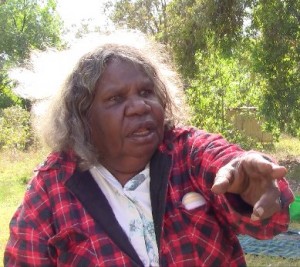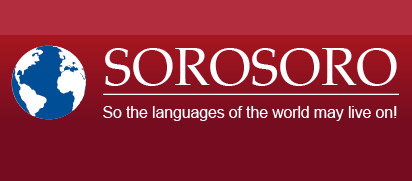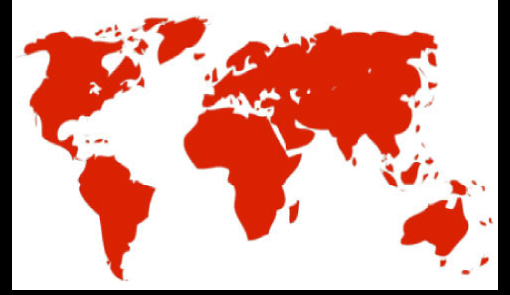Print  |
|


The Australian tradition of multilingualism and the post-colonial context
Posted by Maïa Ponsonnet on March 21, 2011
By Maïa Ponsonnet, Doctor in Philosophy, adjunct researcher at CREDO (Centre de recherche et de documentation sur l’Océanie, CNRS, Marseille), and PhD Scholar in the Linguistics Department of the Australian National University, Canberra. Maïa Ponsonnet has been working with the Dalabon community, in the Northern Territory of Australia, on the documentation of Dalabon and Kriol in particular, since 1998.

Maggie Tukumba, speaker of Dalabon, a threatened language of Arnhem Land, Australia, recording her language with Maïa Ponsonnet. Photo extracted from a video by Matthieu Rabusseau.
“Sorry, I don’t speak ‘Aboriginal’”
When explaining my work and research activities with the Dalabon Aboriginal group of Northern Australia, I sometimes face the following question: “Do you speak Aboriginal?” Sometimes the question comes from Europeans, who tend to view Australia as a large but culturally uniform entity; sometimes it comes from Australians who have not been exposed to the multilingual patterns of Aboriginal communities in their own country.
This idea of a linguistically homogeneous Indigenous Australia is a complete misrepresentation. Specialists estimate that in 1788, when the first British colonists settled in Sydney, the continent would have hosted some 250 distinct languages (dialects excluded). Most Australian Indigenous groups regard language as a crucial identity marker: Aboriginal people often use language names more or less like ethnic labels, that is, as the names for larger social groups above the family and clan levels.
Australian long lasting, broad scale multilingualism
This linguistic patch-work and the identity function of languages, however, did not prevent communication between groups. Surely, representatives of groups in the far North had no opportunity to communicate with groups in the Southern region, for instance. Individuals did not walk across the 3000km wide continent, nor did they walk even half that distance to gather at Uluru/Ayers Rock. However, individuals and groups did communicate and exchange goods, skills, spouses, rituals, across large regions, by means of physical movements or by means of intermediaries, each group exchanging with its closest neighbours, weaving a fine social network.
Multilingualism is both a condition and a result of such an exchange network. Among Australian Indigenous people, learning several languages is usually considered a spontaneous process, occurring along the normal course of growing up and becoming an adult. The idea is that a child should naturally learn the languages of his or her mother and closest ascendants first – which can amount three or four languages. Further languages may also be acquired when marrying someone speaking yet another language, or when interacting with other groups in the course of rituals or various social exchanges. Thus linguistic skills are necessary to interact socially as an accomplished adult; but such skills are also a consequence of these interactions: the fact that a child can normally hear several languages spoken in his immediate environment is a consequence of intermarriage between different linguistic groups, the core of social exchange.
Australian linguistic diversity today
Nowadays, in most regions of Australia, the actual situation no longer matches this traditional pattern. Many languages have disappeared, speakers replacing them either by another neighbouring Aboriginal language used as a lingua franca, or by a creole (mostly Kriol, the major Australian creole), or by English (often the variety called Aboriginal English). Out of about 250 languages of the eighteenth century, recent estimates claim that about 145 are still spoken “to some degree” (Lee and Obata, 2010). Among these, many are severely endangered, with only a handful of speakers left. Some 20 languages may be considered healthier, in that they number more speakers (sometimes a few thousands) and are still learnt by children: Warlpiri and Arrente in the Centre, Yolngu Matha, Bininj Gun-wok in Arnhem Land (Top End peninsula, central North), Murrinh-Patha, in the East of the Top End, Tiwi on Tiwi Island (Arafura Sea), Guugu Yimidirr in Queensland, and more…
The most spoken Australian Aboriginal language
However, the most widely spoken Australian Aboriginal language, by far, is now the language called Kriol, a local creole that has developed and spread in various regions of the Top End peninsula in the early twentieth century. Varieties of Kriol currently number at least 20,000 speakers, and reach as far as the Kimberleys.
Kriol enjoys various degrees of recognition among its own speakers. Some communities consider it as a variety of English, as “pidgin”, or “broken English”; other communities have adopted it as a language in its own right, and actually claim their pride and affection for it. In any case, the number of speakers and the dynamism of Kriol make it an important component of Australian linguistic diversity, as well as a key component of contemporary Indigenous multilingualism. But interestingly, at the national level, Kriol remains in the shade.
In spite of some interest and curiosity, main stream Australians know little about Kriol – they often know little about Aboriginal languages, linguistic practices in Indigenous communities, or even about linguistic diversity in general. This relative ignorance isn’t so surprising in an Anglophone monolingual country. But of course, it makes it even harder for Australian Indigenous communities to maintain their traditional multilingualism.








